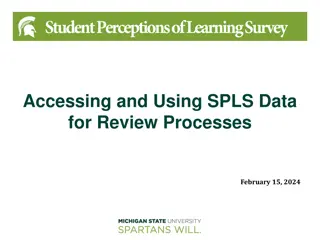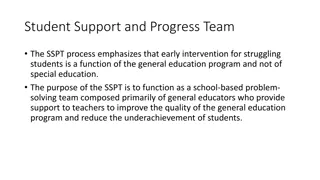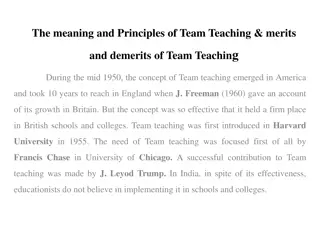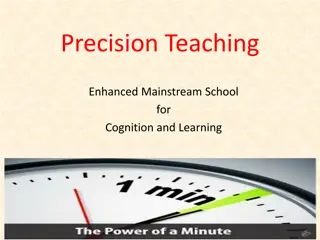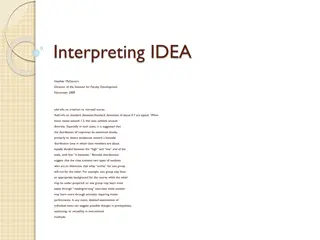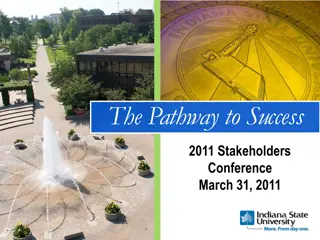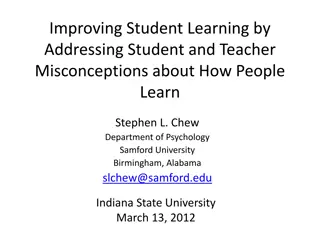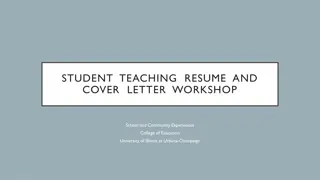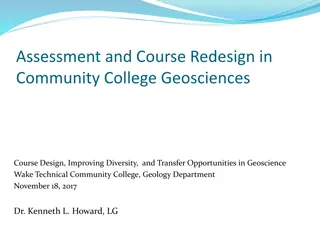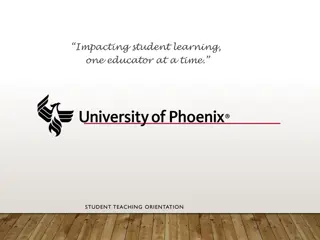Student Success through Team Teaching: A Unique Approach
This publication explores the innovative approach of team teaching in promoting student success at Medicine Hat College. The collaboration between Jodi Clark-Miller and Nora Way showcases the benefits of team-teaching methods in enhancing learning outcomes for diverse groups of students across different educational disciplines.
Download Presentation

Please find below an Image/Link to download the presentation.
The content on the website is provided AS IS for your information and personal use only. It may not be sold, licensed, or shared on other websites without obtaining consent from the author.If you encounter any issues during the download, it is possible that the publisher has removed the file from their server.
You are allowed to download the files provided on this website for personal or commercial use, subject to the condition that they are used lawfully. All files are the property of their respective owners.
The content on the website is provided AS IS for your information and personal use only. It may not be sold, licensed, or shared on other websites without obtaining consent from the author.
E N D
Presentation Transcript
The Road Less Travelled: Student Success through Team Teaching Jodi Clark-Miller & Nora Way (Faculty) Division of Arts Education & Business March 14, 2017
Team Members JODI NORA Education Education Teaching experience Teaching experience Full Time Faculty Semi-retired Cross disciplinary appointment Part-time faculty
Where in the world is Medicine Hat? Google, 2017
Saamis Teepee (Peters, n.d)
Welcome to Medicine Hat College Medicine Hat College provides education that prepares students for further studies, careers and life. Our people are passionate about unleashing the potential of every student- intellectually, emotionally, spiritually, and socially. Through every encounter we have with students- and all that we do- we seek to recognize and encourage their potential as learners, workers and global citizens. Flickr.com, 2017
Welcome to Medicine Hat College Opportunities to Learn Apprenticeship trades Degrees in partnership with Alberta universities Continuing studies for career enhancement and recruitment University transfer allowing students to start degrees here Conservatory of Music and Dance Certificate, diploma, and applied degree programs for careers and employment English as a Second Language Campuses in Medicine Hat and Brooks College preparation
Our Situation University Transfer Sociology Course: Current Social Issues Students: 1st and 2nd year University Transfer Students (Arts, Sciences, and Education) Diploma students Addictions Counselling, Social Work, Child and Youth Care Counsellor, Occupational/Physical Therapist Assistant, and Speech- Language Pathologist Assistant.
Team Teaching: Operational Definitions Team-teaching Co-teaching The instructors work together but do not necessarily teach the same groups of students nor necessarily teach at the same time (Goetz, 2000). Two or more instructors are teaching the same students at the same time within the same classroom (Goetz, 2000). Our experience has been a combination of team and co-teaching. We are presently teaching this course for the 3rd time.
Faculty Perspective Positives Challenges Breadth of experiences Educational Professional Personal Interdisciplinary Reciprocity of mentoring Innovation in evaluation Brainstorming Affirmation/Validation Open Communication Sharing successes and frustrations Commitment Time Trust * Availability Workload Triangulation
Students Review of Literature Challenges Positives Confusion Different perspectives encourages deeper engagement (Woods, 2007) Decreases focus Expanded critical thinking (Hoare, et. al., 2008) Less substantive and rigorous (Bucci and Trantham, 2014) Collective dialogue (Game and Metcalfe, 2009)
Student Perspective Diversity and experiences make the topics and classroom interesting Styles are different but have not created confusion in expectations Assignment and grading expectations are clearly communicated Rarely do we communicate with a student without including the other instructor Students have adapted to different styles The students understand that we are a team Students know our schedule and we stress contact format
Lessons Learned Outline topics Outline schedule Design evaluation methods Agree on rigor Meet often prior to course Communicate frequently Equity in workload Have fun and encourage each other
References Bucci, L. & Trantham, S. (2014). Children and violence: An undergraduate course model of interdisciplinary co-teaching. International Journal of Teaching and Learning in Higher Education. 26(1), 122-131. Flickr.com. (n.d.). Retrieved from http://www.bing.com/images/search?view=detailV2&ccid=CgoF2gLE&id=7E5AA3974670DDFB2594E0E4A2B2CAAC67A918CB&q= medicine+hat+college+image&simid=608031529277129075&selectedIndex=4&qpvt=medicine+hat+college+image&ajaxhist=0 Goetz, K. (2000). Perspectives on Team Teaching: A Semester I Independent Inquiry. Retrieved from http://people.ucalgary.ca/~egallery/goetz.html Google. (2017). Retrieved from https://www.mapcustomizer.com/ Hoare, A., Cornell, S., Bertram, C., Gallager, K., Herslop, S., Lievan, N., & Wilmore, C. (2008). Teaching against the grain: Multi-disciplinary teamwork effectively delivers a successful undergraduate unit in sustainable development. Environmental Educational Research, 14(4), 469-481. Peters, H. (n.d.). The Saamis Teepee. Retrieved from http://hammersonpeters.com/?p=500 Woods, C. (2007) Researching and developing interdisciplinary teaching: Towards a conceptual framework for classroom communication. Higher Education, 54(6), 853-866.



